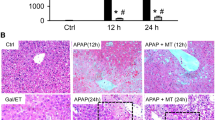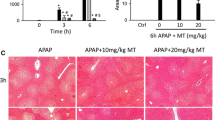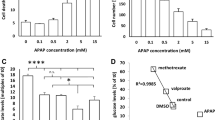Abstract
Morphological changes in mitochondria are observed early in the course of acetaminophen (AA)-induced hepatotoxicity, and mitochondrial dysfunction has been observed both in vivo and in vitro following exposure to AA. This study examined the early effects of AA exposure in vivo on mitochondrial respiration and evaluated the effectiveness ofN-acetyl-L-cysteine (NAC) in protecting against respiratory dysfunction. Mitochondria were isolated from the livers of fasted, male CD-1 mice 0, 0.5, 1, 1.5 or 2 h after administration of a hepatotoxic dose of AA (750 mg/kg). Glutamate- and succinate-supported mitochondrial respiration were subsequently assessed by polarographic measurement of state 3 (ADP-stimulated) and state 4 (resting) rates of oxygen consumption and determination of the corresponding respiratory control ratios (RCR: state 3/state 4) and ADP:O ratios. Hepatotoxicity was assessed histologically and by measuring plasma alanine aminotransferase (ALT) activity. The earliest sign of mitochondrial dysfunction observed in this study was a significant decrease in the ADP:O ratio for the oxidation of glutamate 1 h post-dosing. At 1.5 and 2 h post-dosing the RCRs for both glutamate- and succinate-supported respiration were significantly decreased. All of the respiratory parameters measured in this study were significantly decreased, with the exception of succinate-supported state 4 respiration which was significantly increased, 2 h after AA administration. Thus, inhibition of mitochondrial respiration preceded overt hepatic necrosis, indicated by an elevation of ALT activity, which was not observed until 3 and 4 h post-dosing. In addition, mitochondrial respiratory dysfunction correlated with morphological alterations. Inhibition of mitochondrial respiration therefore appears to be an early event in the course of AA-induced hepatotoxicity. Cotreatment with NAC (1200 mg/kg) completely prevented the AA-induced impairment of mitochondrial respiration and the development of histopathologic damage. The protection afforded by NAC in these experiments indicates thatN-acetyl-p-benzoquinone imine (NAPQI), the reactive metabolite of AA, is responsible for the observed inhibitory effects, and suggests that mitochondrial dysfunction makes an important, if not essential, contribution to the development of AA-induced hepatotoxicity.
Similar content being viewed by others
References
Albano E, Rundgren M, Harvison PJ, Nelson SD, Moldeus P (1985) Mechanisms ofN-acetyl-p-benzoquinone imine cytotoxicity. Mol Pharmacol 28: 306–311
Andersson BS, Rundgren M, Porubek DJ, Nicotera P, Nelson SD, Moldeus P (1989) Arylation and oxidation in paracetamol-induced hepatotoxicity. Adv Biosci 76: 5–11
Andersson BS, Rundgren M, Nelson SD, Harder S (1990)N-Acetyl-p-benzoquinone imine-induced changes in the energy metabolism in hepatocytes. Chem Biol Interact 75: 201–211
Brand MD, Harper M, Taylor HC (1993) Control of the effective P/O ratio of oxidative phosphorylation in liver mitochondria and hepatocytes. Biochem J 291: 739–748
Burcham PC, Harman AW (1988) Effect of acetaminophen hepatotoxicity on hepatic mitochondrial and microsomal calcium contents in mice. Toxicol Lett 44: 91–99
Burcham PC, Harman AW (1990) Mitochondrial dysfunction in paracetamol hepatotoxicity: in vitro studies in isolated mouse hepatocytes. Toxicol Lett 50: 37–48
Burcham PC, Harman AW (1991) Acetaminophen toxicity results in site-specific mitochondrial damage in isolated mouse hepatocytes. J Biol Chem 266: 5049–5054
Carafoli E (1987) Intracellular calcium homeostasis. Annu Rev Biochem 56: 395–433
Corcoran GB, Todd EL, Racz WJ, Hughes H, Smith CV, Mitchell JR (1985a) Effects ofN-acetylcysteine on the disposition and metabolism of acetaminophen in mice. J Pharmacol Exp Ther 232: 857–863
Corcoran GB, Racz WJ, Smith CV, Mitchell JR (1985b) Effects ofN-acetylcysteine on acetaminophen covalent binding and hepatic necrosis in mice. J Pharmacol Exp Ther 232: 864–872
Erecinska M, Wilson BF (1982) Regulation of cellular energy metabolism. J Membr Biol 70: 1–14
Estabrook RW (1967) Mitochondrial respiratory control and the polarographic measurement of ADP:O ratios. In: Estabrook RW, Pullman ME (eds) Methods in enzymology, vol 10. Academic Press, New York, pp 41–47
Esterline RL, Ji S (1989) Metabolic alterations resulting from the inhibition of mitochondrial respiration by acetaminophen in vivo. Biochem Pharmacol 38: 2390–2392
Esterline RL, Ray SD, Ji S (1989) Reversible and irreversible inhibition of hepatic mitochondrial respiration by acetaminophen and its toxic metabolite,N-acetyl-p-benzoquinoneimine (NAPQI). Biochem Pharmacol 38: 2387–2390
Flanagan RJ, Meredith TJ (1991) Use ofN-acetylcysteine in clinical toxicology. Am J Med 91 (suppl 3C): 131S-139S
Johnson D, Lardy H (1967) Isolation of liver and kidney mitochondria. In: Estabrook RW, Pullman ME (eds) Methods in enzymology, vol 10. Academic Press, New York, pp 94–96
Jollow DJ, Mitchell JR, Potter WZ, Davis DC, Gillette JR, Brodie BB (1973) Acetaminophen-induced hepatic necrosis. II. Role of covalent binding in vivo. J Pharmacol Exp Ther 187: 195–202
Kamiyama T, Sato C, Liu J, Tajiri K, Miyakawa H, Marumo F (1993) Role of lipid peroxidation in acetaminophen-induced hepatotoxicity: comparison with carbon tetrachloride. Toxicol Lett 66: 7–12
Katyare SS, Satav JG (1989) Impaired mitochondrial oxidative energy metabolism following paracetamol-induced hepatotoxicity in the rat. Br J Pharmacol 96: 51–58
Kyle ME, Miccadei S, Nakae D, Farber JL (1987) Superoxide dismutase and catalase protect cultured hepatocytes from the cytotoxicity of acetaminophen. Biochem Biophys Res Commun 149: 889–896
Lowry OH, Rosebrough NJ, Farr AL, Randall RJ (1951) Protein measurement with the Folin phenol reagent. J Biol Chem 193: 265–275
Massey TE, Racz WJ (1981) Effects ofN-acetylcysteine on metabolism, covalent binding, and toxicity of acetaminophen in isolated mouse hepatocytes. Toxicol Appl Pharmacol 60: 220–228
Meyers LL, Beierschmitt WP, Khairallah EA, Cohen SD (1988) Acetaminophen-induced inhibition of hepatic mitochondrial respiration in mice. Toxicol Appl Pharmacol 93: 378–387
Mitchell JR, Jollow DJ, Potter WZ, Davis DC, Gillette JR, Brodie BB (1973a) Acetaminophen-induced hepatic necrosis. I. Role of drug metabolism. J Pharmacol Exp Ther 187: 185–199
Mitchell JR, Jollow DJ, Potter WZ, Gillette JR, Brodie BB (1973b) Acetaminophen-induced hepatic necrosis. IV. Protective role of glutathione. Pharmacol Exp Ther 187: 211–217
Nicotera P, Rundgren M, Porubek DJ, Cotgreave I, Moldeus P, Orrenius S, Nelson SD (1989) On the role of Ca2+ in the toxicity of alkylating and oxidizing quinone imines in isolated hepatocytes. Chem Res Toxicol 2: 46–50
Placke ME, Ginsberg GL, Wyand DS, Cohen SD (1987) Ultrastructural changes during acute acetaminophen-induced hepatotoxicity in the mouse. A time and dose study. Toxicol Pathol 15: 431–438
Ramsay RR, Rashed MS, Nelson SD (1989) In vitro effects of acetaminophen metabolites and analogs on the respiration of mouse liver mitochondria. Arch Biochem Biophys 273: 449–457
Raphael SS, Culling CFA, Hyde TA, Inwood MJ, Mellor LD, Sergovich F, Spencer F, Thomson S (1976) Lynch’s medical laboratory technology. vol 2, 3rd ed. WB Saunders, Philadelphia, pp 876–1062
Raucy JL, Lasker JM, Lieber CS, Black M (1989) Acetaminophen activation by human liver cytochromes P450IIE1 and P450IA2. Arch Biochem Biophys 271: 270–283
Sordahl LA, Johnson C, Blailock ZR, Shwartz A (1971) The mitochondrion. In: Schwartz A (ed) Methods in pharmacology, vol 1. Appleton-Century-Crofts, New York, pp 247–286
Streeter AJ, Dahlin DC, Nelson SD, Baillie TA (1984) The covalent binding of acetaminophen to protein. Evidence for cysteine residues as major sites of arylation in vitro. Chem Biol Interact 48: 349–366
Stryer L (1988) Biochemistry, 3rd ed., WH Freeman, New York, pp 397–424
Thomas CE, Reed DJ (1989) Current status of calcium in hepatocellular injury. Hepatology 10: 375–384
Tirmenstein MA, Nelson SD (1989) Subcellular binding and effects on calcium homeostasis produced by acetaminophen and a nonhepatotoxic regioisomer, 3′-hydroxyacetanilide, in mouse liver. J Biol Chem 264: 9814–9819
Tirmenstein MA, Nelson SD (1990) Acetaminophen-induced oxidation of protein thiols. J Biol Chem 265: 3059–3065
Vermeulen NPE, Bessems JGM, Van de Straat R (1992) Molecular aspects of paracetamol-induced hepatotoxicity and its mechanism-based prevention. Drug Metab Rev 24: 367–407
Walker RM, Racz WJ, McElligott TF (1980) Acetaminophen-induced hepatotoxicity in mice. Lab Invest 42: 181–189
Walker RM, Massey TE, McElligott TF, Racz WJ (1981) Acetaminophen-induced hypothermia, hepatic congestion, and modification byN-acetylcysteine in mice. Toxicol Appl Pharmacol 59: 500–507
Wendel A, Feurerstein S, Konz KH (1979) Acute paracetamol intoxication of starved mice leads to lipid peroxidation in vivo. Biochem Pharmacol 28: 2051–2055
Yamamoto K, Kawanishi S (1991) Oxidation of specific SH protein of mitochondria by photodynamic action of hematoporphyrin. Biochem Pharmacol 42: 1087–1092
Author information
Authors and Affiliations
Rights and permissions
About this article
Cite this article
Donnelly, P.J., Walker, R.M. & Racz, W.J. Inhibition of mitochondrial respiration in vivo is an early event in acetaminophen-induced hepatotoxicity. Arch Toxicol 68, 110–118 (1994). https://doi.org/10.1007/s002040050043
Received:
Accepted:
Issue Date:
DOI: https://doi.org/10.1007/s002040050043




